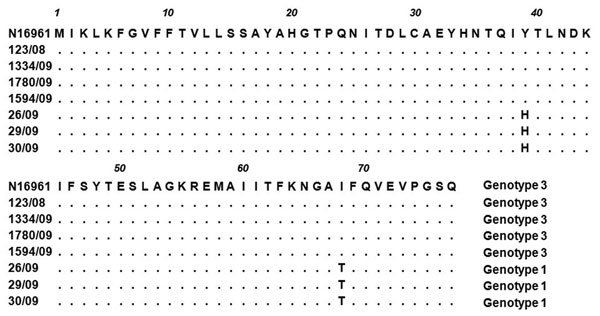Volume 18, Number 7—July 2012
Dispatch
Outbreak-associated Vibrio cholerae Genotypes with Identical Pulsotypes, Malaysia, 2009
Figure 2

Figure 2. . . Amino acid sequence alignment of the ctxB subunit of representative Vibrio cholerae isolates from the cholera outbreak, Terengganu, Malaysia, 2009. El Tor O1 N16961 (ctxB3) was used as the reference strain in the alignment. Identical amino acid residues are indicated by dots. Two genotypes (1,3) were observed in the outbreak strains.
References
- Mandomando I, Espasa M, Valles X, Sacarlal J, Sigauque B, Ruiz J, Antimicrobial resistance of Vibrio cholerae O1 serotype Ogawa isolated in Manhica District Hospital, southern Mozambique. J Antimicrob Chemother. 2007;60:662–4. DOIPubMedGoogle Scholar
- Teh CSJ, Chua KH, Thong KL. Genetic variation analysis of Vibrio cholerae using multilocus sequencing typing and multi-virulence locus sequencing typing. Infect Genet Evol. 2011;11:1121–8. DOIPubMedGoogle Scholar
- Ang GY, Yu CY, Balqis K, Elina HT, Azura H, Hani MH, Molecular evidence of cholera outbreak caused by a toxigenic Vibrio cholerae O1 El tor variant strain in Kelantan, Malaysia. J Clin Microbiol. 2010;48:3963–9. DOIPubMedGoogle Scholar
- Chen CH, Shimada T, Elhadi N, Radu S, Nishibuchi M. Phenotypic and genotypic characteristics and epidemiological significance of ctx+ strains of Vibrio cholerae isolated from seafood in Malaysia. Appl Environ Microbiol. 2004;70:1964–72. DOIPubMedGoogle Scholar
- Teh CSJ, Thong KL, Ngoi ST, Ahmad N, Nair GB, Ramamurthy T. Molecular characterization of serogrouping and virulence genes of Malaysian Vibrio cholerae isolated from different sources. J Gen Appl Microbiol. 2009;55:419–25. DOIPubMedGoogle Scholar
- Okada K, Roobthaisong A, Nakagawa I, Hamada S, Chantaroj S. Genotypic and PFGE/MLVA analyses of Vibrio cholerae O1: geographical spread and temporal changes during the 2007–2010 cholera outbreaks in Thailand. PLoS ONE. 2012;7:e30863. DOIPubMedGoogle Scholar
- Clinical and Laboratory Standards Institute (CLSI). Performance standards for antimicrobial susceptibility testing. 18th informational supplement. CLSI document M100–S18. Wayne (PA): The Institute; 2008.
- Centers for Disease Control and Prevention. Pulsenet USA. The national molecular subtyping network for foodborne disease surveillance: rapid standard laboratory protocol for molecular subtyping of Vibrio cholerae by pulse-field gel electrophoresis (PFGE). 2006.
- Olsvik O, Wahlberg J, Petterson B, Uhlen M, Popovic T, Wachsmuth IK, Use of automated sequencing of polymerase chain reaction–generated amplicons to identify three types of cholera toxin subunit B in Vibrio cholerae O1 strains. J Clin Microbiol. 1993;31:22–5.PubMedGoogle Scholar
- Ranjit K, Nurahan M. Tetracycline resistant cholera in Kelantan. Med J Malaysia. 2000;55:143–5.PubMedGoogle Scholar
- Teh CSJ, Chua KH, Thong KL. Multiple-locus variable-number tandem repeat analysis of Vibrio cholerae in comparison with pulsed field gel electrophoresis and virulotyping. J Biomed Biotechnol. 2010;2010:817190. DOIPubMedGoogle Scholar
- Safa A, Nair GB, Kong RY. Evolution of new variants of Vibrio cholerae O1. Trends Microbiol. 2010;18:46–54. DOIPubMedGoogle Scholar
- Tran HD, Alam M, Trung NV, Van Kinh N, Nguyen HH, Pham VC, Multi-drug resistant Vibrio cholerae O1 variant El Tor isolated in northern Vietnam between 2007 and 2010. J Med Microbiol. 2012;61:431–7. DOIPubMedGoogle Scholar
Page created: June 07, 2012
Page updated: June 07, 2012
Page reviewed: June 07, 2012
The conclusions, findings, and opinions expressed by authors contributing to this journal do not necessarily reflect the official position of the U.S. Department of Health and Human Services, the Public Health Service, the Centers for Disease Control and Prevention, or the authors' affiliated institutions. Use of trade names is for identification only and does not imply endorsement by any of the groups named above.